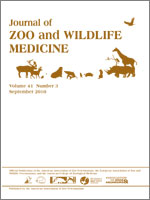BioOne.org will be down briefly for maintenance on 14 May 2025 between 18:00-22:00 Pacific Time US. We apologize for any inconvenience.
REVIEW ARTICLES (15)
BRIEF COMMUNICATIONS (14)
BOOK REVIEWS (2)
ERRATUM (1)
Articles (2)

Ophthalmic Examination Findings in A Captive Colony of Western Gray Kangaroos (Macropus fuliginosus)
No abstract available
No abstract available
No abstract available
No abstract available
No abstract available
